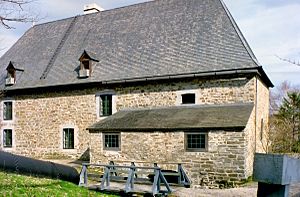Moulin du Petit-Pré facts for kids
The Moulin du Petit-Pré, also called Moulin de Monseigneur-de-Laval, is a very old water mill in Château-Richer, Quebec, Canada. It sits near the St. Lawrence river, not far from Quebec City. This mill is special because it's the oldest working flour mill in North America! It was built a long time ago, between 1691 and 1695, for the Seminary of Quebec, thanks to Bishop François de Laval.
Over its long history, this mill has done many jobs. It ground wheat into flour, cut wood, and even processed wool. It also faced tough times, being damaged by fire three times. Today, the mill is an important historical place in Quebec, showing us about the past.
Contents
The Mill's Amazing History
The Moulin du Petit-Pré was built by Charles Pouliot between 1691 and 1695. It used the power of the Petit-Pré River to grind wheat into flour. This flour was then sold to local people. Jean Richard was the very first person to work as a miller here.
In 1702, a fire damaged the mill. But don't worry, it was fixed just four years later! This brought the mill back to its original working condition. More repairs and improvements happened between 1732 and 1744. In 1742, the building was even made bigger to hold a third grinding machine.
Rebuilding and New Uses
In 1759, during a big battle, the mill was burned down by British General James Wolfe. But the mill was important, so it was rebuilt over the next five years. Two new grinding machines were put in. A lot of the money for these repairs came from Antoine Nadeau, who had been renting the mill since 1757.
In 1778, a third grinding machine was added by the seminary. Later, in 1810, Charles Bélanger got permission to add a saw mill to the building. This saw mill was finished in 1819. After Quebec changed its old land system, the mill also started to process wool. Joseph Coté helped make this new use possible.
In 1871, the seminary sold the mill, which now included a saw mill, flour mill, and wool processing area. The new owner was George Benson Hall, Jr.. Six years later, another fire destroyed the mill. But once again, it was quickly rebuilt! This time, it got a modern turbine instead of the old water wheel.
In 1877, the mill was sold to Richard Temblay. He later gave it to his son, also named Richard, in 1889. In 1897, Zoé Richard bought the mill. Her daughter then inherited it in January 1925.
The Mill in Modern Times
In 1944, a group called Château-Richer Cooperative took over the mill. Then, in 1965, Pierre Jobidon bought it. Just one year later, the Ministry of Cultural Affairs purchased the mill. In the 1970s, experts dug up parts of the mill to learn more about its past. This helped them restore it to how it looked around 1763.
By 1982, the mill was used for some local government offices and a cultural center. In 1995, a company called Gestion Promiel Inc. became the owner. Then, in 2002, a new group was formed to do even more restoration work. This work was finished in 2003.
What the Mill is Used For Today
Since 2003, the Moulin du Petit-Pré has been a small cultural history museum. Visitors can explore the mill and learn about its past. It also has a bistro, a place for events, and hosts different community activities. In 2003, it even won an award for being a great new tourist attraction in Quebec!
See also
- List of watermills
- List of windmills in Quebec



